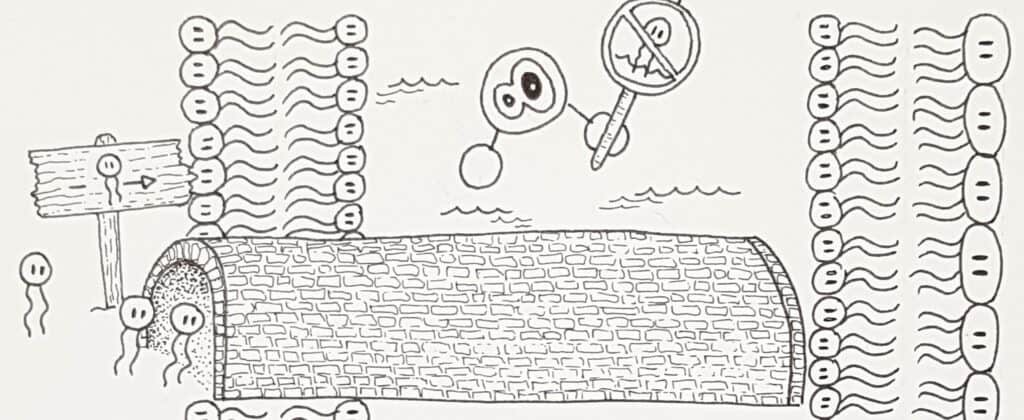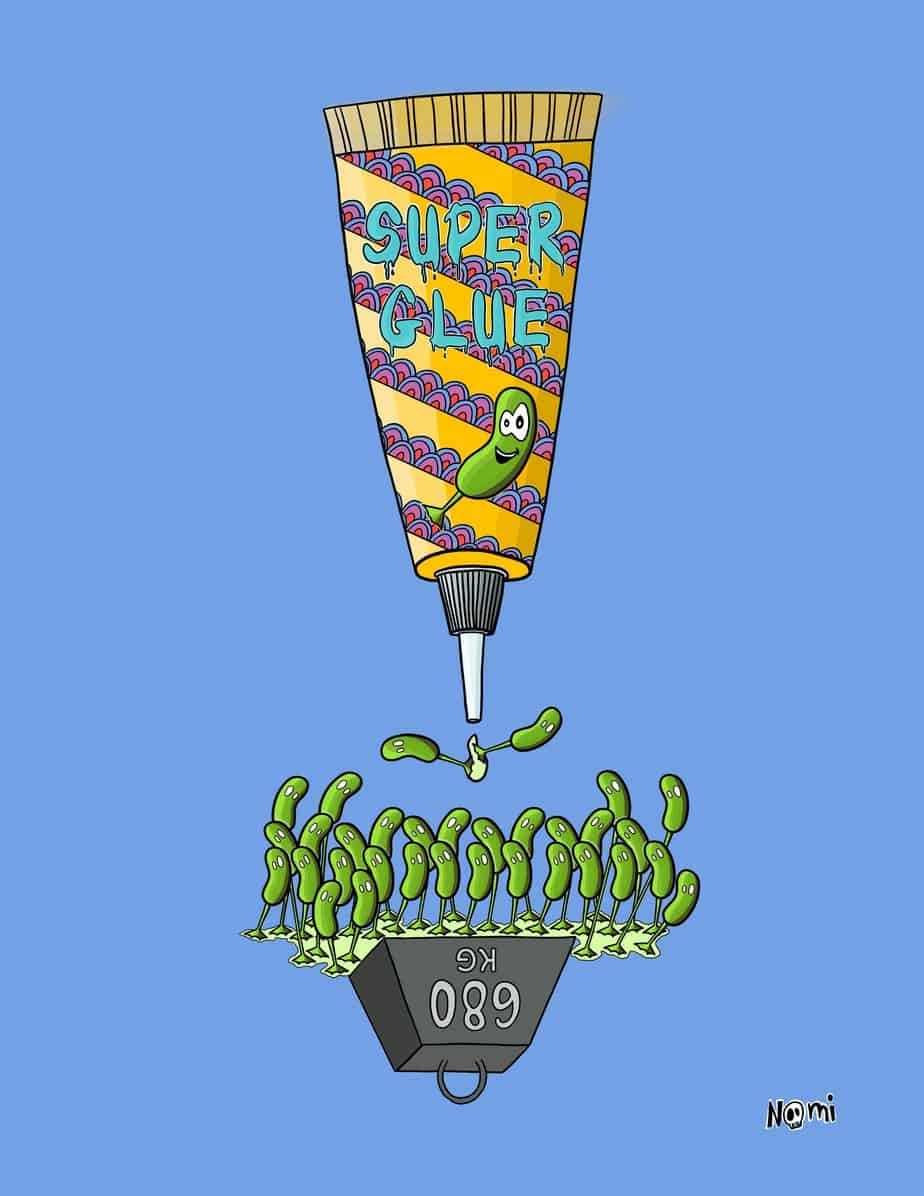Have you ever thought that when you were growing, your skin had to grow with you? How the skin surface needs to increase so that your body could expand?
Imagine this on a bacterial scale. When a bacterial cell grows, it not only increases its cellular content but also the cell envelope. The bacterial membrane. And the bacterial membrane is like our skin. It needs to grow with the cell.
But how do bacteria grow their membranes?
How do they increase the surface of their membranes to hold the cell content?
Let’s answer these questions by understanding what exactly the bacterial cell envelope looks like.
The double membranes of Gram-negative bacteria
Yes, Gram-negative bacteria have more than one bacterial membrane. They have two – an inner and an outer membrane.

As you can see in the picture, the inner and the outer membranes look a bit different. This is because they are made of different lipids. Let’s look at them in more detail:
Lipids in the bacterial inner membrane
The bacterial inner membrane contains phospholipids. These molecules always remind me of stick figures.

A phospholipid has one head and two legs. The head of the lipid is negatively charged and likes water – it is hydrophilic. On the other side, the legs are hydrophobic, so they do not like water. They prefer to stick together with hydrophobic legs from other lipid molecules.
Hence, phospholipids arrange like this: Their legs contact other lipid legs and hide from water. The lipid heads stick together with other heads looking towards the water.
As such, countless phospholipids assemble to a big lipid layer. And such a layer surrounds the cytosol of the bacterium – as the inner membrane.
Lipids in the bacterial outer membrane
The bacterial outer membrane has different lipids on the inside and on the outside. The inner side of the outer membrane also contains phospholipids and assemble similarly to what I described above.
Yet, the outside of the bacterial outer membrane is made of lipopolysaccharides.
In stick figure terms, lipopolysaccharides have very big heads because they contain sugars. And depending on the bacterium, lipopolysaccharides have between two and five hydrophobic legs. Also, most lipopolysaccharide heads wear massive hats which are made of fancy sugars. And these sugary hats look different in each bacterium.

As you can see in the picture above, the lipopolysaccharide heads with their sugary hats look to the outside of the bacterium. And their legs interact with the legs from the phospholipids and hide from water.
Like this, the outer membrane completely surrounds the bacterial inner membrane. And the space between the inner and the outer membrane is called the periplasm.
Bacteria have more stuff in their membranes
Bacterial membranes do not only contain lipids. There are proteins too and bacteria need these to live.
For example, transporter proteins import stuff to feed the bacterium or export waste. The bacterium also holds sensors in the membrane to measure what is going on outside.
Now, we know what the membranes of bacteria look like. Let’s have a look at how bacteria grow these membranes.
How bacteria grow their membranes
When a Gram-negative bacterial cell grows, it needs to grow both its membranes. And for that, it needs to transport lipids into the membranes.
BUT bacteria produce lipids inside the cytosol. So, how can a bacterium send lipids to the outer membrane? There are a whole membrane and periplasm in the way. And the periplasm is basically water with stuff inside and, as we saw before, lipids do not like being in water.
To overcome these obstacles, bacteria use some cool mechanisms: ferries, tunnels and bridges.
Bacteria use lipid tunnels to transport phospholipids to the outer membrane
Bacteria produce phospholipids very close to the inner membrane. So, directly after bacteria produce phospholipids, they insert them into the inner membrane. They live here anyway.
But some of these phospholipids need to reach the other side of the periplasm – the outer membrane. Therefore, these phospholipids use a tunnel that goes through the periplasm and all the way to the outer membrane.
For this, a protein sits in the inner membrane and pushes phospholipids into the tunnel. The tunnel then moves in waves to transport the phospholipids towards the other side. Here, the phospholipids are directly inserted into the outer membrane.

Like this, the tunnel shields phospholipids from the watery periplasm and transports them.
Bacteria use lipid ferries to shuttle phospholipids back and forth
A lipid ferry is another mechanism of how bacteria grow their outer membranes.
This mechanism involves a transporter that sits in the inner membrane. This transporter takes phospholipids from the inner membrane and hands them over to a ferry protein.
This ferry protein shuttles back and forth between the inner and the outer membrane. But it only saves seats for phospholipids. Therefore, it picks up phospholipids on the inner membrane and drops them off at the outer membrane.

Like this, the lipid ferry transports phospholipids and shields them from the watery periplasm.
Bacteria build lipid bridges to transport lipopolysaccharides to the outer membrane
Lipopolysaccharides have by far the farthest to travel to their final destination.
Bacteria produce lipopolysaccharides close to the inner membrane where they are immediately inserted. A specific transporter then flips the lipopolysaccharide to the other side of the inner membrane.
On the periplasmic side, the flipping transporter hands over the lipopolysaccharide to a bridge. This bridge connects the inner membrane with the outer membrane.
And researchers think that adding a new molecule at the bottom of the bridge pushes other molecules along. Eventually, they then reach the outer membrane. Here, the lipopolysaccharide molecule meets another transporter that flips it to the outside of the outer membrane.

And this is how a lipopolysaccharide molecule makes its way from the cytosol to the surface of the bacterial outer membrane.
Why do we need to know how bacteria grow their membranes?
Here, we explored three mechanisms of how bacteria transport lipids to the outer membrane: tunnels, ferries and bridges. With these mechanisms, bacteria grow their membranes by increasing their lipid content and surfaces. This allows the whole cell to grow and expand.

As soon as we understand how bacteria grow, we can try to inhibit this process.
So, researchers try to understand the mechanisms and the transporters involved. Then they might find molecules that inhibit these machines. An idea would be to stop the lipid transport so that bacteria cannot grow their membranes. This would halt bacterial growth in general and eventually the bacterium would die. Hence, this would be another mechanism to fight antimicrobial resistance.









4 Responses
Nice cartoonification of the process, very comprehensive :)
Thank you :)
Amazing drawings and extremely helpful description. Thank you so much. I hope it is alright that my son (aged 13 yrs) has copied out your drawings for a children’s book he is illustrating, citing your blog in the credits at the bottom of the drawing?
Thank you so much for your kind words. And of course, that is fine and we’re incredibly honoured that we’re part of a children’s book now :)